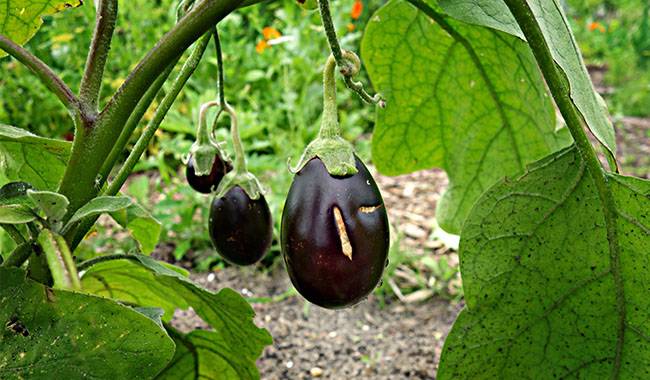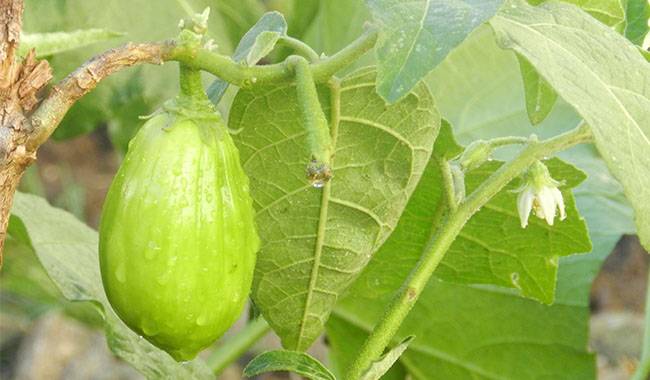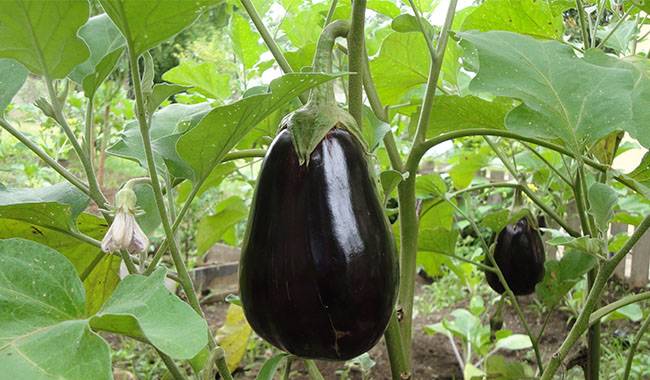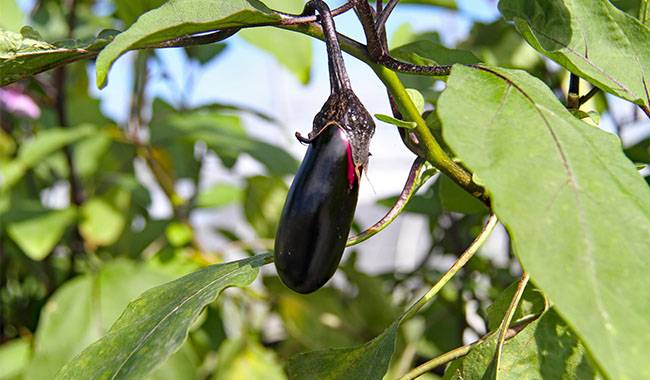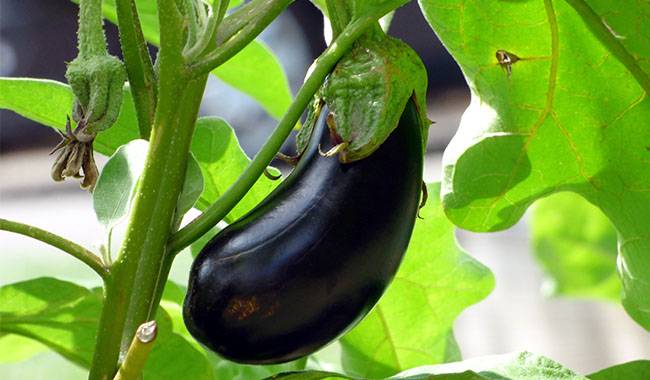
Eggplant needs full sun but relatively short days, average warm temperatures without being debilitating, and adequate moisture but not watering of the root system.
It is quite difficult to provide these conditions in the open spaces of most of the United States. Therefore, eggplant used to be grown only in protected areas, where the necessary conditions for such cultivation were artificially created.
With the development of breeding, it is possible to grow eggplant outdoors, not only in the southern part of the United States and the countries of the Commonwealth but in all regions.
With the right agronomic techniques, even in areas of the United States where the climate is not conducive to eggplant growth, including the northwestern part of Europe, the most popular “purple” crop will give gardeners a happy yield.
PREPARING RAISED BEDS FOR EGGPLANTS
The best predecessors of eggplant are early cabbage, beans, cucumbers, carrots, different kinds of onions, melons, zucchini, beans.
Eggplant should not (due to the same pests and diseases) be grown after the eggplant family (tomatoes, potatoes). Cultivation requires temporary isolation, i.e. return to the previous cultivation site no earlier than 3-5 years.
Loamy or sandy loam soils are the best for eggplants. The culture will also grow on thick soils if it is grown by continuous application of fresh fertilizer, agricultural vermiculite, sand, mulch, overexposed sawdust (non-coniferous), or other materials that increase the permeability and air permeability of the soil.
Eggplant needs to have a well-lit area in the crop rotation. Shade from tall crops or vegetables on trellises (cucumbers, beans) is not allowed.
Eggplant harvesting requires a lot of nutrients from the field, so the soil in this cultivation is thoroughly filled with organic and mineral fertilizers.
For autumn “refueling” use autumn-sown green manures and their subsequent embedding or contribute to an area of 1 m2 by 6-10 kg of humus, mature compost. Add 200-250 g of wood ash and 50-60 g of nitroglycerine.
Digging on the complete bayonet of the shovel to remove the hard (for fragile eggplant roots) bottom is formed by constant shallow digging of 6-8inch (15-20 cm). It is more practical to do the digging in late fall. Late digging destroys the dens of some bears that spend the winter in the soil.
PREPARING THE SOIL FOR EGGPLANTS IN SPRING
If for environmental reasons, the plot does not have time to be fertilized in the fall, you can sow glycosides in the spring in a future eggplant bed.
Alternatively, replace the green manure with hummus and add a mineral fertilizer in the same dosage as in the fall.
PLANTING SEEDLINGS IN OPEN SPACES
When to plant eggplant outdoors?
Growing eggplant shoots outdoors in southern regions does not cause difficulties. The soil in the root zone warms up to 62-64°F (17-18°C) and the air temperature is within 64-75°F (18-24°C), creating optimal conditions for eggplant seedlings.
Eggplant seedlings can reach 65-70 days of age. By this period, they will have a well-developed root system of 5-8 well-developed leaves and 1-2 buds.
In areas with a temperate climate, additional measures are needed to prepare the seedbed for growing eggplant seedlings. If the soil is very cold, raise the bed 12-16inch (30-40 cm) with bulk soil. In autumn, it is advisable to lay the bed with semi-prepared sod and other materials that will raise the soil temperature when they decompose.
Eggplants in the middle zone are planted outdoors in the first decade of June, sometimes later. For planting can be (unlike other vegetables) seedlings 70-75-80 days old, with at least 3-5-7 developed leaves.
How to plant eggplant seedlings?
To prevent plants from shading each other, it is more practical to use a row planting scheme, placing seedlings in a row after 17-23inch (45-60 cm) and between rows after 23-30inch (60-80 cm), depending on the habit of the future bush.
In a well 4-6-7inch (10-15-18 cm) deep, mix a handful of wood ash and a tablespoon of calcium superphosphate. In order not to damage the fragile and brittle root system of the eggplant, the seedlings should be planted in a clump of moist soil. The root system in the well should not be broken.
Pour the soil from the seedlings into the hole, knead it easily (without much effort), and water with warm water 64-86°F (18-30°C), you can – a weak solution of manganese. Watered eggplant plants should be mulched with any fine dry ground cover (upland peat, 2-3-year-old non-pine sawdust, hummus, etc.).
Caring for eggplants outdoors
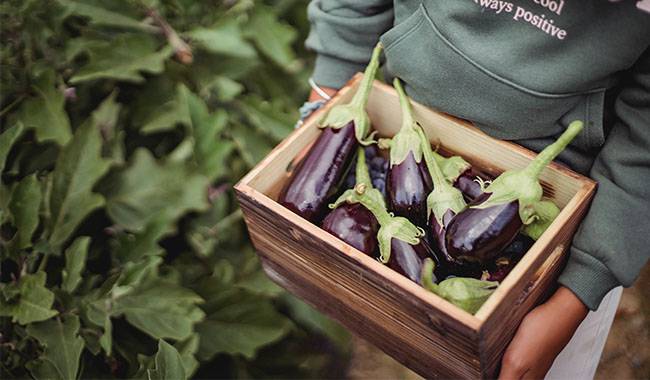
Lighting
Eggplants like bright sunlight, which should not exceed 12 hours in the first month and 12-14 hours thereafter. Under 12 hours of light, eggplants rapidly enter the flowering and fruiting stage. With longer light hours, they may be limited to developing asexual reproduction without flowering and fruiting.
Therefore, you should always have a cover material on hand to limit the light entering this crop.
Temperature range
Eggplants require a high-temperature regime of soil and air. The temperature of the soil should be no less than 60°F (16°C) and its optimum temperature varies between 62-64°F (17-18°C). The air should reach 64-75°F (18-24°C) during the day and 59-64°F (15-18°C) at night.
There are varieties that develop normally with an average daily air temperature of 59°F (15°C).
Eggplant development should also be adversely affected by prolonged cold rains. During the flowering period, a reduction in air temperature to 53°F (12°C) can lead to the expulsion of flowers and ovaries, and further reductions can lead to the death of the culture. Prevent this from happening – water with heated water and build temporary shelters.
Eggplant watering
Watering is always warm, heated in the sun (in the south) and in mild climates with cold soil, irrigation water is heated to 77-86 °F (25-30 °C). Eggplants can be watered just below the roots. If water gets to the surface of the leaves, the leaves become sick, photosynthesis decreases and the plant stops developing.
Make the first watering within 10-12 days after planting outdoors. If the weather is dry and hot, then within 7-9 days. The soil should be constantly moist, but not more than 65-70% (eggplant roots do not tolerate waterlogging and excessive soil moisture).
From the flowering and ovary formation stage, increase watering, soaking the soil to a 6-8inch (15-20 cm) layer, and watering once a week (in 5-7 days).
Feeding of eggplant
Root feeding of eggplant is carried out once in 2-3 weeks during vegetation. During flowering and ovary formation, plants are treated by spraying with boric acid, trace element set, and other foliar spray solutions.
The first feeding of eggplant is carried out within 10-12 days after planting seedlings outdoors (reference point: the appearance of a new leaf on a forming bush).
Considering that the vegetative mass of eggplant grows very slowly in the first month, fertilize with a fertilizer containing nitrogen at a rate of 30-40 g/10 liters of water (1.0-1.5 liters per bush).
If you don’t have these fertilizers, you can make an ammonia-phosphorus solution at a rate of 150 g of fertilizer per 10 liters of water.
The second feeding of the eggplant in 12-15 days spends a mixture of wood ash, which will replenish the root layer with trace elements, and a complete fertilizer (phosphorus nitrate or ammonium nitrate) at a rate of 20-25 grams per bush or 40-50 grams per square meter.
In the second application of fertilizer, you can apply an extract of poultry manure instead of the recommended mixture. Soak 2-3 kg of poultry manure in 10 liters of water for 2-3 days, filter it and dilute it in 10-15 liters of warm water and irrigate each bush under the roots at a rate of 1.0-1.5 liters.
Fertilization of eggplants during the flowering stage can be effectively done with nutrition, dichlorvos or nutrition 35-40 g/m2 area and boric acid foliar spray solution (1 g dissolved in 5 liters of hot water, cooled and sprayed on the plants).
Foliar applications of micronutrients or fermented herb solutions can be repeated during the flowering and fruiting stages.
As the eggplant starts to set, apply a phosphorus-potassium mixture (calcium superphosphate and potassium sulfate) at a rate of 40-50 grams per square meter.
Eggplants are harvested several times and to maintain the results (especially in low fertility soils), they can be fertilized again with phosphorus and potassium fertilizers after the first or second harvest.
The fertilizer market nowadays offers a wide range of nutrients to maintain and increase soil fertility in order to provide nutrition for vegetable crops (composts, complexes, organic minerals, etc.).
In any case, there is no need to overfeed eggplants by applying large doses of fertilizers, especially nitrogen, in the second half of the growing season. The plant will then develop large biomass, which is detrimental to the development of the fruit.
Eggplant weeding
The soil under the eggplant should always be loose and moist, free of soil crusts and weeds. Loosening should be done shallowly so as not to damage the root system, on the 2nd day after watering, preferably by raking (soaking) the soil with a rake.
Shaping and germination of eggplants
Eggplants do not like an unnecessary intervention. Therefore, low-growing and dwarf varieties do not need bush structuring. Bushes are formed when they reach a height of 10-12inch (25-30 cm).
Late formation of eggplant (excision of large stems with ovaries) severely injures the bush and leads to disease and sometimes death. Check the bearing (central) stem.
Pinch off the stems located in the leaf axils until they reach the first bud. If the plant is stunted, you can also remove the first bud. This method stimulates the development of roots and stems and has a positive effect on the formation of flowers and ovaries.
In addition, eggplant bushes are formed in different ways.
Early, low-growing eggplant varieties with small fruit mass (200-250 g) and 2-5 stems are usually left unstructured and only provide proper care.
If the eggplant variety is early or medium maturing and forms many ovaries and the fruit is characterized by medium weight (up to 250-400 g), cut off up to 20-25% of the flowers, regardless of the region in which they are cultivated.
The rest of the flowers form larger fruits. If all the flowers are left, the fruits will be small, and many of them will be underdeveloped.
Eggplant bushes are vigorous, heavily branched, and large in size, usually formed by medium- and late-maturing varieties, and are mainly grown in southern regions.
Such bushes form 1-2-3 stems and are tied to a trellis in several places to prevent large fruits (up to 450-900 g) from falling off the branches.
On each branch, 1 ovary is left and the rest is removed by pruning (it is better to cut them off neatly with shears). With such formation, each bush will have 5-7-8 fruits weighing up to 1 kg. The stems of eggplants grow slowly and can be checked every 2 weeks.
Towards autumn, prune the tops of the eggplant bushes and remove all the small fruits. They will no longer grow, but they will draw back some nutrients.
OUTDOOR PEST AND DISEASE PROTECTION FOR EGGPLANT
Eggplant is a multi-harvestable crop. Eggplant fruits are removed at technical maturity when they reach a standard size, color, flesh density (determined by pressing on the fruit), and other characteristics. However, prior to harvest, eggplants are subject to diseases and pests throughout the growing season.
In the case of multiple harvests, the use of chemical protectants is prohibited. Therefore, preventive measures and the use of biological agents are the basis for protection. Biological agents can be used from the first days after sowing in the field until harvest.
Eggplants are a “delicacy” for pests, and their activity increases dramatically as warm weather builds up. They damage the leafy apparatus, flowers, ovaries, and fruits. The greatest damage is caused by aphids, whiteflies, spider mites, and thrips.
It is recommended that the use of biological agents can effectively eliminate pests.
If the requirements of agricultural technologies are violated, plants are often affected by fungal and bacterial rots, viral mosaic. In such cases, appropriate biological agents will help. Biological preparations for disease prevention effectively protect plants.
Remember! Biological preparations are effective at certain temperatures and follow all necessary conditions for breeding, preparation of tank mixtures, and plant treatment. Violation of recommendations (in particular, increasing the concentration of the solution, treatment during cold periods, etc.) will not have the desired effect.
In addition to biological preparations, you can use folk methods to protect plants from pests and diseases.




